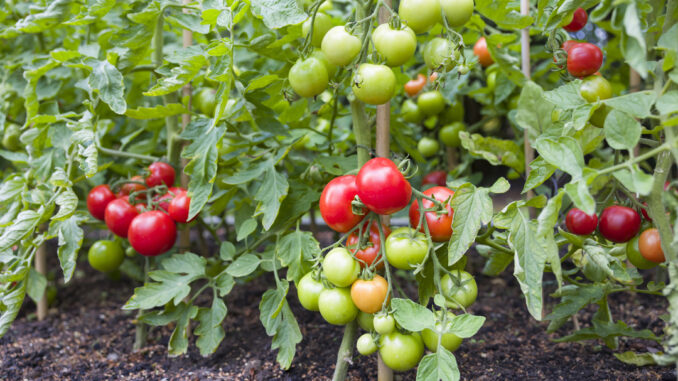
Now that you’re home for another Canadian summer, why not encourage the best that your garden can offer. Here are some tricks to making tomatoes sweeter, and flowers more abundant.
Making tomato bliss
One thing which we know is true – no one wants to eat a tasteless tomato. We might not expect a supermarket tomato purchased in January to have appreciable flavour. But a homegrown tomato from your own garden in July should provide the classic sweet and tart flavour that is a summer dream come true. Have we attained the maximum flavour potential from garden tomatoes, or is there anything that we can do to make them even better?
Rich, well-draining soil; a minimum of six hours of sun daily; and, adequate moisture will encourage productive tomato plants. Their natural vigour is impressive, and they’ll take root in almost any garden crack with the bare necessities of plant life. However, strong stem and leaf growth doesn’t influence fruit flavour.
Tomato flavour is determined by inherited genetics that trend toward sweetness, available minerals in the soil, and a balance of acids (malic and citric acids) and sugars (glucose and fructose) within the fruits. Providing garden fertilizers with the standard nutrients (nitrogen, phosphorus and potassium) won’t cause tomatoes to be sweet. Additional organic minerals and micronutrients will appreciably increase flavour and sugar content in tomatoes. With the basics of soil, light and water provided, what remains to consider is delivering the organic elements that are going to result in superior flavour.
Minerals vital to plant health and fruit flavour come from the earth’s rock beds and from the native soils and oceans overlaying the rock. The mineral content of commercial field soils are frequently ‘grown out’ of essential minerals. Thankfully, home garden growing doesn’t require soil analysis for mineral content. It’s sufficient to provide an organic fertilizer with a broad spectrum of mineral content. Fertilizers manufactured from rock and aquatic plants and fish are rich in the taste-making minerals which tomatoes require.
Look for fertilizers made from sea products. Kelp seaweed is a rich source of minerals and health-boosting elements, and is sold as dry kelp meal or as a liquid spray. Any kind of fish emulsion is relished by tomato plants and produces demonstrable results. Some fish emulsions have the predictable fishy odour, but deodorized products (and also dry fish meal) are available.
Rock dust fertilizers are good plant foods, rich in minerals and micronutrients. There are various kinds of rock dust sources (glacial, volcanic basalt and azomite). Glacial rock dust is easy to source and works well in our Canadian landscape. It’s made from the dust of rocks picked up by glaciers and tumbled around as the ice flows moved across the continent. (This is truly ancient plant food!) Rock dust fertilizer delivers essential calcium, iron, magnesium and potassium, as well as a full list of micronutrients. Follow package directions and use it to top dress plants in containers and garden beds, or mix it into soil. These rock and sea fertilizer products are easily available by internet search.
Certainly the flavourful proof is in the pudding, so to speak. You’ll know if your tomatoes are sweeter when using mineral supplements. Sugar content of any fruit, vegetable or liquid can be measured with a small, hand-held refractometer − an affordable tool which you can find through an internet search (it makes a thoughtful birthday gift). Sugar content is expressed as degrees Brix, a scale of sweetness with an upper number of 20. Fresh tomatoes grown for processing are 3.5 to 5.5 Brix, and that is not particularly sweet at all. Round cherry and grape-shaped tomatoes have more sugar and can rate 6 to 10 Brix. Any Brix rating higher than 7 is getting toward a sweet flavour, and some cherry tomatoes will rate a sugar-rich 12 to 14 Brix. You can test the sugar content rating of everything in your refrigerator, and the refractometer provides quite a lot of fun for gardeners!
Keep them blooming
Summer flowering annual and perennial plants expend a great deal of energy in their first phase of bloom. Thereafter, annuals may bloom not quite so generously and perennials will stop flowering entirely. There are two ways to extend the blooming period of flowering plants, and you can be ready to step in and encourage lots more flowers to come.
Annuals will quickly come back into bud when long leggy stems are pinched back by a third of their length, and the plants are given a water-soluble fertilizer every second week. Using a commercial ‘bloom buster’ fertilizer with a higher middle number (such as 5-15-5) will promote more flowers and not so many leaves.
Perennial plants bloom for selective periods of time, usually about three to four weeks, before shutting down their flowering phase for the season. Their sole purpose in blooming is to make seeds. Once the flowers have faded and the seed heads are developing, the perennial plants won’t make any more flowers for the current growing season. You can interrupt that process and generate more flower buds by quickly removing (or dead heading) spent blooms before their seed-making centres get busy. The plant will notice that its seed development has been removed and put out further flower buds. And you will have generated at least two more weeks to the flowering season for that perennial plant.


